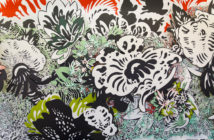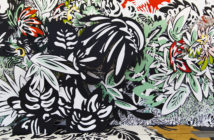My life is worn out. Well, let's pretend, let's do nothing! oh, pitiful! And we will exist, and amuse ourselves, dreaming of monstrous loves and fantastic worlds, complaining and quarreling with the appearances of the world, acrobat, beggar, artist, bandit, - priest!
–Arthur Rimbaud, “A Season In Hell,” 1873
Philadelphia-based artist Alex Da Corte has remixed Arthur Rimbaud’s nineteenth-century raison d’être to new depths in his sprawling solo show, Free Roses, at the Massachusetts Museum of Contemporary Art. The ten-year survey’s opening gallery shares its title with a particularly wicked chapter from Rimbaud’s magnum opus, “A Season in Hell,” as do several more of Da Corte’s installations throughout the retrospective. Immersive, disorienting, and utterly spectacular, Da Corte’s all-encompassing installations mine Pop vernacular in lurid Technicolor. The artist’s sensibility halts just short of hysteria, couching his eight-foot Kleenex boxes and pupil-popping color-worlds in a tone less mocking than oddly tender. Dreamscapes purr with neon and slow-spinning plastic swans, diffusing intent through Symbolist surreality and Disney-fied domestic unrest. From sex to pop culture to the contents of your bedside table, nothing familiar escapes the artist’s lens.
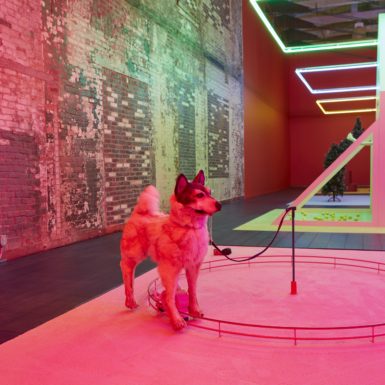
Lightning (detail), 2015-2016. Installation of Alex Da Corte: Free Roses, MASS MoCA. Courtesy the artist and Luxembourg & Dayan Gallery, New York.
Photo: John Bernardo.
The first and largest room of the exhibit, entitled Lightning, interrogates the reaches of that influence with wit to spare. Seven squares of carpet, complete with visible vacuum tracks, set the stage for tightly curated funhouse tableaux that abstract the trappings of suburban life—a house façade, a mustard-hued living room, a yard replete with tennis balls. The results feel operatic in their eeriness. Four unassuming deviled eggs decorate the leftmost edge of a rug-anchored chimney. Two sections over, a stuffed Akita lurches disquietingly around its circular track. Visual puns abound throughout Lightning like pancakes nestled quietly amongst lily pads and a mound of soil directly adjacent to its black felt “grave.” A separate gallery houses a reworking of Joseph Beuys's Lightning with Stag in its Glare (1958-85). Da Corte relegates constituent parts to a smaller circle, steeping them in a deep green glow. In each room, light plays an authorial role in our reading of space and object, immediately and purposefully informing the viewer’s affective relationship with the piece. Still, for all his accessible and not-so-accessible references to Looney Tunes, movie musicals and hallucinogens, Da Corte’s works never feel cluttered. His dogged attention to formalism gleans whimsy from chaos, drawing our attention past appropriation politics towards a more radical end.
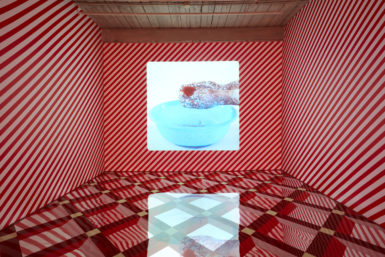
Lattice Hypnagogia (Scene One), 2014. Edition of 5. Chelsea Hotel No. 2, 2010, installation of Alex Da Corte: Free Roses, MASS MoCA. Courtesy the artist. Photo: John Bernardo.
Da Corte’s two-dimensional pieces pale in comparison to his more ambitious installations. The carpet-smothered gallery following Lightning contains a few thoughtful multimedia paintings and screenprints, but it’s Da Corte’s videos that really showcase his peculiar brand of magic. In Chelsea Hotel #2, close-ups of hands performing suggestive actions with kitchen items (shaking a soda bottle to the point of explosion, for instance) coexist with a five-foot-long rubber sculpture of a hoagie. Easternsports–Da Corte’s bizarre, kaleidoscopic collaboration with Dev Hynes and Jayson Musson–is set apart in an adjoining room. It depicts enigmatic characters enacting a three-hour re-imagining of Thornton Wilder’s play Our Town in four freestanding wall projections. The sets’ meticulous symmetry lends order to otherwise fractured perception. Like much of the work on display in Free Roses, it simply can’t be absorbed as a whole. Da Corte’s assemblages seduce the viewer through tandem gestures of inclusion and denial, simultaneously inviting and controlling the visitor’s gaze. Our strained eyes and careful footsteps emphasize our tourist status in the simulacrum of normality that Da Corte has built. His artistic grammar might remain consistent, but the totems in question conduct and shed meaning with the ease of a studio lot, troubling the wonder so central to their approach. There is no panoptic option; Da Corte places us directly at the mercy of selective illusion. The triumph of Free Roses lies not in the artist’s ability to wow his audience, but in his willingness to call us out on our own false consciousness.
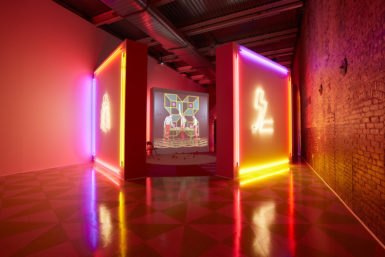
Alex Da Corte and Jayson Musson, Easternsports, 2014. Installation of Alex Da Corte: Free Roses, MASS MoCA. Easternsports was commissioned by the Institute of Contemporary Art, University of Pennsylvania. Photo: John Bernardo.

